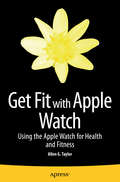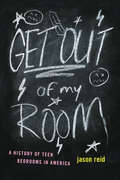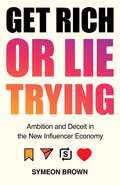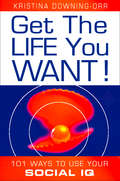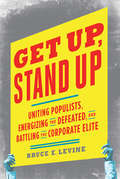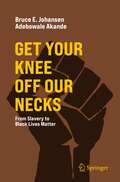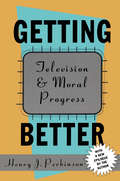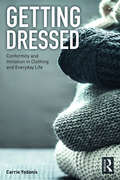- Table View
- List View
Gesundheitswirtschaft als Motor der Regionalentwicklung (Gesundheit. Politik - Gesellschaft - Wirtschaft)
by Elke Dahlbeck Josef HilbertDie Gesundheitswirtschaft ist in den letzten 20 Jahren eine wichtige Säule der Regionalwirtschaft geworden. Die Branche ist nicht nur ein bedeutender Wertschöpfungs- und Beschäftigungsträger, sondern ein wichtiger Motor für Innovationen sowohl innerhalb der Branche als auch darüber hinaus in andere Branchen. Dementsprechend ist der Leitmarkt Gesundheit mittlerweile ein fester Bestandteil regionaler Innovationsstrategien. Der Band gibt einen Überblick über allgemeine Grundlagen und Methoden zur regionalen Gesundheitswirtschaft, über Gesundheitsherausforderungen und -chancen im internationalen Vergleich sowie über Innovationschancen und -blockaden in ausgewählten Feldern der regionalen Gesundheitswirtschaft.Mit seinem Erscheinen in der Reihe „Gesundheit. Politik – Gesellschaft – Wirtschaft“ (hrsg. von E.-W. Luthe und J. N. Weatherly) steht das Buch für die wachsende Erkenntnis, Gesundheitspolitik als interdisziplinäre Aufgabe zu betrachten.
Get Fit with Apple Watch: Using the Apple Watch for Health and Fitness
by Allen TaylorGet Fit with Apple Watch is the concise introduction to the amazing new Apple Watch. It's the first book specifically focused on the Apple Watch's most important function: health and fitness.This book is for you if you are interested in health and are willing to make small lifestyle adjustments in order to enhance health and well-being. This book is also for you if you are a dedicated health junkie who already exercises on a regular basis and follows a healthy diet. The Apple Watch includes fitness apps that you can access right on your wrist while you are exercising, for instant feedback on how you are doing.You will learn how to use the Watch to avoid sitting for too long, to register a healthy amount of body movement every day, and how to get the most out of more strenuous exercise activities. All fitness and exercise-related built-in apps will be covered in detail, as well as leading third party health and fitness apps that have been specifically tailored to work with the Watch.Part I plus two appendixes give readers just what they need to know to understand all functionality of the Apple Watch to set up their Apple Watch, and what third-party apps are available (at time of publication). It's a great mini-book that will be appeal to readers who don't feel the need to buy an entire standalone introduction to the Apple Watch.Part II (the majority of the book) clearly explains the Apple Watch's fitness and health-tracking functions, but goes well beyond this by showing readers different ways to integrate these functions into their daily lives, regular workout routines, and with their iPhone and the leading third-party health and fitness apps. Plus, there's an entire chapter devoted to the Apple Watch Research Kit, explaining the benefits of the associated medical research apps and how users can participate in these world-changing programs, should they choose to.Veteran technology author Allen Taylor is also a participant in the Apple Watch Research Kit study in cardiovascular fitness conducted by Stanford University.
Get in Gear: The Seven Gears that Drive Strategy to Results
by Sean T. RyanGet in Gear: The Seven Gears that Drive Strategy to Results (978-0-367-47149-1, 335422) Shelving Guide: Business and Management/Leadership/Strategy Only 10% to 25% of organizations get it right when it comes to achieving the expected results from their strategic planning. This means 75% to 90% of them are leaving results on the table and wasting their time on things that don’t matter. Almost a decade ago, a major steel manufacturer approached Sean Ryan and his team to help them think through how to better convert strategy to results. This was the catalyst for the seven gears that translate strategy to results found in Strategy-Execution-Results (SXR). Why Gears? Gears transmit energy. The more aligned they are and the less friction in their chain, the better they function. Leaders can easily identify the gear creating the most friction and then take action to better align that gear with the strategy generating better results. This creates momentum to improve the alignment and performance of other gears. This approach also emphasizes the ways everyone in the organization has some influence over every gear. Based on Sean Ryan’s consulting and training with organizations from start-ups to the Fortune 100, he’s found that these performance gears drive better results. You’ll employ them to align your goals with your strategy, create visible scorecards to know whether or not you’re on track, and identify the critical behaviors and actions that will drive performance. Readers will use this book to point their efforts toward getting meaningful results from their strategy. As noted in the Harvard Business Review: "The prize for closing the strategy-performance gap is huge: increasing performance by at least 50% for most organizations." After moving beyond their initial amazement of just how misaligned they were, they’ll be able to quickly apply the seven gears to sell better and more, drive down costs, improve quality and safety, and recruit talent for the future. In addition, there’s nothing in this book that has not been applied in actual business settings. While companies could use the SXR™ Framework to overhaul their organization top to bottom, they’ll also appreciate that they don’t have to change everything at once to make progress. Upon understanding each of the gears and how to create Follow-up and Follow-through, they’ll be able to improve any gear to start seeing strategic outcomes. You’ve got it in Gear, now Stay in Gear. Join the Strategy-Execution-Results Community: www.wwici.com/Gearheads.
Get in Gear: The Seven Gears that Drive Strategy to Results
by Sean T. RyanGet in Gear: The Seven Gears that Drive Strategy to Results (978-0-367-47149-1, 335422) Shelving Guide: Business and Management/Leadership/Strategy Only 10% to 25% of organizations get it right when it comes to achieving the expected results from their strategic planning. This means 75% to 90% of them are leaving results on the table and wasting their time on things that don’t matter. Almost a decade ago, a major steel manufacturer approached Sean Ryan and his team to help them think through how to better convert strategy to results. This was the catalyst for the seven gears that translate strategy to results found in Strategy-Execution-Results (SXR). Why Gears? Gears transmit energy. The more aligned they are and the less friction in their chain, the better they function. Leaders can easily identify the gear creating the most friction and then take action to better align that gear with the strategy generating better results. This creates momentum to improve the alignment and performance of other gears. This approach also emphasizes the ways everyone in the organization has some influence over every gear. Based on Sean Ryan’s consulting and training with organizations from start-ups to the Fortune 100, he’s found that these performance gears drive better results. You’ll employ them to align your goals with your strategy, create visible scorecards to know whether or not you’re on track, and identify the critical behaviors and actions that will drive performance. Readers will use this book to point their efforts toward getting meaningful results from their strategy. As noted in the Harvard Business Review: "The prize for closing the strategy-performance gap is huge: increasing performance by at least 50% for most organizations." After moving beyond their initial amazement of just how misaligned they were, they’ll be able to quickly apply the seven gears to sell better and more, drive down costs, improve quality and safety, and recruit talent for the future. In addition, there’s nothing in this book that has not been applied in actual business settings. While companies could use the SXR™ Framework to overhaul their organization top to bottom, they’ll also appreciate that they don’t have to change everything at once to make progress. Upon understanding each of the gears and how to create Follow-up and Follow-through, they’ll be able to improve any gear to start seeing strategic outcomes. You’ve got it in Gear, now Stay in Gear. Join the Strategy-Execution-Results Community: www.wwici.com/Gearheads.
Get in the Game: How to Level Up Your Business with Gaming, Esports, and Emerging Technologies
by Jonathan StringfieldAn essential guide for marketers and execs wishing to integrate their brands with modern games and esports In Get in the Game: How to Level Up Your Business with Gaming, Esports, and Emerging Technologies, decorated gaming and social media research and marketing executive Jonathan Stringfield delivers a roadmap to understanding and navigating marketing and business integrations into the gaming ecosystem: who plays games (and why), how modern games are created and oriented around the world of esports, and where brands can get involved with modern games. This book explains the breadth and depth of the gaming audience, describing the rapidly changing demographics of modern games and the various motivations gamers have for playing games. It also unpacks the history of gaming and how it has impacted the creative processes and output from the industry. Finally, it offers a practical guide for brands wishing to integrate themselves into new gaming environments, with an emphasis on maximizing success for marketers, developers, content creators, and fans. Get in the Game provides: A thorough introduction to why marketers and executives must pay closer attention to gaming, as well as existing roadblocks to understanding the gaming industry Comprehensive explorations of the psychology and motivations of gaming, and implications towards messaging and brand safety. Practical discussions of gaming as a competitive platform or streaming viewing experience. In-depth examinations of gaming ad placements, deep marketing integrations between companies and games, and future directions for the industry and how it relates to the emergence of the metaverse.Perfect for marketing strategists, brand managers, and Chief Marketing Officers, Get in the Game will also earn a place in the libraries of executives seeking to connect with the misunderstood yet largest segment in consumer entertainment.
Get in the Game: How to Level Up Your Business with Gaming, Esports, and Emerging Technologies
by Jonathan StringfieldAn essential guide for marketers and execs wishing to integrate their brands with modern games and esports In Get in the Game: How to Level Up Your Business with Gaming, Esports, and Emerging Technologies, decorated gaming and social media research and marketing executive Jonathan Stringfield delivers a roadmap to understanding and navigating marketing and business integrations into the gaming ecosystem: who plays games (and why), how modern games are created and oriented around the world of esports, and where brands can get involved with modern games. This book explains the breadth and depth of the gaming audience, describing the rapidly changing demographics of modern games and the various motivations gamers have for playing games. It also unpacks the history of gaming and how it has impacted the creative processes and output from the industry. Finally, it offers a practical guide for brands wishing to integrate themselves into new gaming environments, with an emphasis on maximizing success for marketers, developers, content creators, and fans. Get in the Game provides: A thorough introduction to why marketers and executives must pay closer attention to gaming, as well as existing roadblocks to understanding the gaming industry Comprehensive explorations of the psychology and motivations of gaming, and implications towards messaging and brand safety. Practical discussions of gaming as a competitive platform or streaming viewing experience. In-depth examinations of gaming ad placements, deep marketing integrations between companies and games, and future directions for the industry and how it relates to the emergence of the metaverse.Perfect for marketing strategists, brand managers, and Chief Marketing Officers, Get in the Game will also earn a place in the libraries of executives seeking to connect with the misunderstood yet largest segment in consumer entertainment.
Get Out of My Room!: A History of Teen Bedrooms in America
by Jason ReidTeenage life is tough. You’re at the mercy of parents, teachers, and siblings, all of whom insist on continuing to treat you like a kid and refuse to leave you alone. So what do you do when it all gets to be too much? You retreat to your room (and maybe slam the door). Even in our era of Snapchat and hoverboards, bedrooms remain a key part of teenage life, one of the only areas where a teen can exert control and find some privacy. And while these separate bedrooms only became commonplace after World War II, the idea of the teen bedroom has been around for a long time. With Get Out of My Room!, Jason Reid digs into the deep historical roots of the teen bedroom and its surprising cultural power. He starts in the first half of the nineteenth century, when urban-dwelling middle-class families began to consider offering teens their own spaces in the home, and he traces that concept through subsequent decades, as social, economic, cultural, and demographic changes caused it to become more widespread. Along the way, Reid shows us how the teen bedroom, with its stuffed animals, movie posters, AM radios, and other trappings of youthful identity, reflected the growing involvement of young people in American popular culture, and also how teens and parents, in the shadow of ongoing social changes, continually negotiated the boundaries of this intensely personal space. Richly detailed and full of surprising stories and insights, Get Out of My Room! is sure to offer insight and entertainment to anyone with wistful memories of their teenage years. (But little brothers should definitely keep out.)
Get Out of My Room!: A History of Teen Bedrooms in America
by Jason ReidTeenage life is tough. You’re at the mercy of parents, teachers, and siblings, all of whom insist on continuing to treat you like a kid and refuse to leave you alone. So what do you do when it all gets to be too much? You retreat to your room (and maybe slam the door). Even in our era of Snapchat and hoverboards, bedrooms remain a key part of teenage life, one of the only areas where a teen can exert control and find some privacy. And while these separate bedrooms only became commonplace after World War II, the idea of the teen bedroom has been around for a long time. With Get Out of My Room!, Jason Reid digs into the deep historical roots of the teen bedroom and its surprising cultural power. He starts in the first half of the nineteenth century, when urban-dwelling middle-class families began to consider offering teens their own spaces in the home, and he traces that concept through subsequent decades, as social, economic, cultural, and demographic changes caused it to become more widespread. Along the way, Reid shows us how the teen bedroom, with its stuffed animals, movie posters, AM radios, and other trappings of youthful identity, reflected the growing involvement of young people in American popular culture, and also how teens and parents, in the shadow of ongoing social changes, continually negotiated the boundaries of this intensely personal space. Richly detailed and full of surprising stories and insights, Get Out of My Room! is sure to offer insight and entertainment to anyone with wistful memories of their teenage years. (But little brothers should definitely keep out.)
Get Out of My Room!: A History of Teen Bedrooms in America
by Jason ReidTeenage life is tough. You’re at the mercy of parents, teachers, and siblings, all of whom insist on continuing to treat you like a kid and refuse to leave you alone. So what do you do when it all gets to be too much? You retreat to your room (and maybe slam the door). Even in our era of Snapchat and hoverboards, bedrooms remain a key part of teenage life, one of the only areas where a teen can exert control and find some privacy. And while these separate bedrooms only became commonplace after World War II, the idea of the teen bedroom has been around for a long time. With Get Out of My Room!, Jason Reid digs into the deep historical roots of the teen bedroom and its surprising cultural power. He starts in the first half of the nineteenth century, when urban-dwelling middle-class families began to consider offering teens their own spaces in the home, and he traces that concept through subsequent decades, as social, economic, cultural, and demographic changes caused it to become more widespread. Along the way, Reid shows us how the teen bedroom, with its stuffed animals, movie posters, AM radios, and other trappings of youthful identity, reflected the growing involvement of young people in American popular culture, and also how teens and parents, in the shadow of ongoing social changes, continually negotiated the boundaries of this intensely personal space. Richly detailed and full of surprising stories and insights, Get Out of My Room! is sure to offer insight and entertainment to anyone with wistful memories of their teenage years. (But little brothers should definitely keep out.)
Get Out of My Room!: A History of Teen Bedrooms in America
by Jason ReidTeenage life is tough. You’re at the mercy of parents, teachers, and siblings, all of whom insist on continuing to treat you like a kid and refuse to leave you alone. So what do you do when it all gets to be too much? You retreat to your room (and maybe slam the door). Even in our era of Snapchat and hoverboards, bedrooms remain a key part of teenage life, one of the only areas where a teen can exert control and find some privacy. And while these separate bedrooms only became commonplace after World War II, the idea of the teen bedroom has been around for a long time. With Get Out of My Room!, Jason Reid digs into the deep historical roots of the teen bedroom and its surprising cultural power. He starts in the first half of the nineteenth century, when urban-dwelling middle-class families began to consider offering teens their own spaces in the home, and he traces that concept through subsequent decades, as social, economic, cultural, and demographic changes caused it to become more widespread. Along the way, Reid shows us how the teen bedroom, with its stuffed animals, movie posters, AM radios, and other trappings of youthful identity, reflected the growing involvement of young people in American popular culture, and also how teens and parents, in the shadow of ongoing social changes, continually negotiated the boundaries of this intensely personal space. Richly detailed and full of surprising stories and insights, Get Out of My Room! is sure to offer insight and entertainment to anyone with wistful memories of their teenage years. (But little brothers should definitely keep out.)
Get Rich or Lie Trying: Ambition and Deceit in the New Influencer Economy
by Symeon Brown'Compelling.' Reni Eddo-LodgeA 'must-read book for 2022', as picked by StylistMore than one fifth of children want to become influencers and it's easy to understand why. What if you could escape economic uncertainty by winning the internet's attention? What if you could turn the adoration of your social media followers into a lucrative livelihood?But as Symeon Brown explores in this searing exposé, the reality is much murkier. From IRL streamers in LA to Brazilian butt lifts, from sex workers on OnlyFans to fraudulent cryptocurrency schemes, these are the incredible stories that lurk behind the filtered selfies and gleaming smiles.Exposing the fraud, exploitation, bribery, and dishonesty at the core of the influencer model, Get Rich or Lie Trying asks if our digital rat race is costing us too much. Revealing a broken economy resembling a pyramid scheme, this incredible blend of reportage and analysis will captivate and horrify you in equal measure.
Get the Life You Want!: 101 Ways To Use Your Social Iq
by Dr. Kristina Downing-OrrWe’ve all heard of emotional intelligence – now find out about how to use your social IQ to make friends, influence people and succeed in life.
Get Up, Stand Up: Uniting Populists, Energizing the Defeated, and Battling the Corporate Elite
by Bruce E. LevinePolls show that the majority of Americans oppose recent US wars and Wall Street bailouts, yet most remain passive and appear resigned to powerlessness. In Get Up, Stand Up, Bruce Levine offers an original and convincing explanation for this passivity. Many Americans are deeply demoralized by decades of oppressive elitism, and they have lost confidence that genuine democracy is possible. Drawing on phenomena such as learned helplessness, the abuse syndrome, and other psychological principles and techniques for pacifying a population, Levine explains how major US institutions have created fatalism. When such fatalism and defeatism set in, truths about social and economic injustices are not enough to set people free. However, the situation is not truly hopeless. History tells us that for democratic movements to get off the ground, individuals must recover self-respect, and a people must regain collective confidence that they can succeed at eliminating top-down controls. Get Up, Stand Up describes how we can recover dignity, confidence, and the energy to do battle. That achievement fills in the missing piece that, until now, has undermined so many efforts to energize genuine democracy. Get Up, Stand Up details those strategies and tactics that oppressed peoples have successfully employed to gain power. We the People can unite, gain strength, wisely do battle, and wrest power away from the ruling corporate-government partnership (the "corporatocracy"). Get Up, Stand Up explains how.
Get Your Knee Off Our Necks: From Slavery to Black Lives Matter
by Bruce E. Johansen Adebowale AkandeThe death of George Floyd on May 25, 2020, and the ensuing trial of Derek Chauvin for murder a year later has rubbed raw the bloodiest stain on the United States’ history and its world reputation. The nine minutes and 29 seconds during which Chauvin’s knee crushed the spark of life out of Floyd was not unusual in the history of the United States. Before the U.S. Civil War, slaves were routinely beaten to death for disobeying orders or running away, then often lynched. In roughly two centuries, Blacks have achieved nominal freedom. But, as this book’s opening chapter and expert essays that follow indicate, freedom has been conditional based on inequity of wealth, social, and legal discrimination. None of this is new in the United States; what is new is the number of people rising up in protest, a figure in the millions around the world after Floyd’s murder.This book supplies a readable, scholarly account of recent issues in race and racism in the United States that will be useful for general readers, undergraduate students, and their professors. It will be useful in many fields, including Black studies, other ethnic pursuits, United States history, law, criminal justice, intercultural communication, et al. The work contains a powerful historical narrative followed by several important, essays on subjects including George Floyd’s murder, the rise of the Black Lives Matter movement and many other victims of systematic racism.
Geteilte Gemeinschaft und mann-männliche Prostitution: Eine ethnografische Studie im Kontext einer Gaststätte
by Holger SchönnagelDie vorliegende ethnografische Studie zur mann-männlichen Prostitution beschreibt Interaktionen und Sichtweisen von Männern im Gaststätten-Kontext und entwickelt daraus Impulse für die Soziale Arbeit in diesem Feld. Es wird vor dem historischen Hintergrund der Verfolgung deutlich, dass die Männer trotz ihrer unterschiedlichen Lebenssituationen oftmals gemeinschaftliche Aspekte verbinden und damit mehr als nur sexuelles Interesse oder der Erwerb materieller Vorteile. Ihre Interaktionen werden in der Studie kategorisiert, es entsteht ein dichtes, sensibles und vielschichtiges Bild des Handelns der jüngeren und älteren Männer dieser Szene, ihrer Gedanken zur Prostitution und ihrer Gefühle füreinander.
Getting Better: Television and Moral Progress
by Bryan GreenEver since the fifties, when television became ascendent in American popular culture, it has become commonplace to bemoan its "bad" effects. Little or nothing, however, has been said about its "good" effects. With this observation, Henry Perkinson introduces his provocative and original analysis of television and culture. Rejecting the determinism inherent in most studies of the effects of television ("We are what we watch"), he insists that it is people that actively change culture, media having no agency to do so. Nevertheless, he argues that television did facilitate the changes we have made in our culture over the past thirty years.Perkinson describes how television helped us become critical of our existing culture, especially of the relationships that were commonly accepted between men and women, blacks and whites, politicians and voters, employers and employees, and between people and the environment. These criticisms have brought about dramatic changes in our social, political, and economic arrangements, as well as changes in our intellectual outlook. Since these changes came about through our efforts to eliminate or reduce discrimination, suffering, and injustice, Perkinson argues that our culture has become more moral in the age of television.In what amounts to a history of recent social change in America, Getting Better examines the role television has played in the rise of feminism, the black protest movement, the presidential elections, the Vietnam War, Watergate, environmentalism, religious fundamentalism, and the New Age movement. This book will be essential reading for students of communications and American culture, and for anyone who wants to make sense of the transformations of American life from the 1950s to the present. Even those who do not agree that things are "getting better" will find that Perkinson's analysis helps to make things more coherent.
Getting Better: Television and Moral Progress
by Bryan GreenEver since the fifties, when television became ascendent in American popular culture, it has become commonplace to bemoan its "bad" effects. Little or nothing, however, has been said about its "good" effects. With this observation, Henry Perkinson introduces his provocative and original analysis of television and culture. Rejecting the determinism inherent in most studies of the effects of television ("We are what we watch"), he insists that it is people that actively change culture, media having no agency to do so. Nevertheless, he argues that television did facilitate the changes we have made in our culture over the past thirty years.Perkinson describes how television helped us become critical of our existing culture, especially of the relationships that were commonly accepted between men and women, blacks and whites, politicians and voters, employers and employees, and between people and the environment. These criticisms have brought about dramatic changes in our social, political, and economic arrangements, as well as changes in our intellectual outlook. Since these changes came about through our efforts to eliminate or reduce discrimination, suffering, and injustice, Perkinson argues that our culture has become more moral in the age of television.In what amounts to a history of recent social change in America, Getting Better examines the role television has played in the rise of feminism, the black protest movement, the presidential elections, the Vietnam War, Watergate, environmentalism, religious fundamentalism, and the New Age movement. This book will be essential reading for students of communications and American culture, and for anyone who wants to make sense of the transformations of American life from the 1950s to the present. Even those who do not agree that things are "getting better" will find that Perkinson's analysis helps to make things more coherent.
Getting By: Estates, class and culture in austerity Britain
by Lisa MckenzieWhile the 1% rule, poor neighbourhoods have become the subject of public concern and media scorn, blamed for society's ills. This unique book redresses the balance. Lisa Mckenzie lived on the St Ann’s estate in Nottingham for more than 20 years. Her ‘insider’ status enables us to hear the stories of its residents, often wary of outsiders. St Ann's has been stigmatised as a place where gangs, guns, drugs, single mothers and those unwilling or unable to make something of their lives reside. Yet in this same community we find strong, resourceful, ambitious people who are 'getting by', often with humour and despite facing brutal austerity.
Getting By: Estates, class and culture in austerity Britain
by Lisa MckenzieWhile the 1% rule, poor neighbourhoods have become the subject of public concern and media scorn, blamed for society's ills. This unique book redresses the balance. Lisa Mckenzie lived on the St Ann’s estate in Nottingham for more than 20 years. Her ‘insider’ status enables us to hear the stories of its residents, often wary of outsiders. St Ann's has been stigmatised as a place where gangs, guns, drugs, single mothers and those unwilling or unable to make something of their lives reside. Yet in this same community we find strong, resourceful, ambitious people who are 'getting by', often with humour and despite facing brutal austerity.
Getting By on the Minimum: The Lives of Working-Class Women
by Jennifer JohnsonFirst published in 2002. Routledge is an imprint of Taylor & Francis, an informa company.
Getting By on the Minimum: The Lives of Working-Class Women
by Jennifer JohnsonFirst published in 2002. Routledge is an imprint of Taylor & Francis, an informa company.
Getting Dressed: Imitation in Clothing and Everyday Life
by Carrie YodanisGetting Dressed introduces students to sociological concepts via the everyday decision of what to wear. Everyone has to get dressed. And what we wear creates our identity – how people define us and how we define ourselves. But getting dressed is not based on our individual choices and tastes alone. Rather, the process of getting dressed is shaped and limited by a range of social influences that lead us to imitate what others wear and reduces the range of options that are available for us to wear. From designers’ studios to the stores in the mall to our bedrooms, social constraints limit creativity and shape what we wear and how we express our identities when getting dressed.
Getting Dressed: Conformity and Imitation in Clothing and Everyday Life
by Carrie YodanisGetting Dressed teaches sociology through the everyday decision of what to wear. It is about the rules that shape how we dress and how and why we conform. It is about how and why we imitate others. We may think about clothing as our personal style and identity. But our personal style is not so personal; it is social, shaped and limited by countless social influences. We use clothes to rank and treat each other as better and worse. Yet we need each other to become who we are when getting dressed. This book is about what we wear, why we wear it, and why it matters.
Getting Even: Public Policies to Tackle Inequality in Asia
by Mustafa TalpurAsia's phenomenal economic growth during last few decades is a remarkable success story in the fight against poverty. Between 2005 and 2012 alone, the number of people living in extreme poverty in Asia-Pacific was reduced by 1.1 billion-accounting for more than 90 per cent of the total poverty reduction achieved worldwide. However, these achievements have been overshadowed by the sharp rise in income and wealth inequality. The concentration of private wealth is of a greater concern. In several countries in Asia, the richest top 5% control close to 70% of the nation's total private wealth; the top 1% control more than 50%. This level of disparity has pervasive consequences for everyone. It stifles social mobility, undermines social cohesion, hurts long-term growth and reinforces inequality of opportunities. It encourages crime, sparks corruption and can lead to violent conflict. Left unchecked, growing inequality undermines the fight to end poverty and more people living with little hope. Such stark inequality is not inevitable – it is the consequence of political and economic choices. Deliberate policy choices have fostered the extremes of income, wealth seen across Asia today. It is against this context that book brings together a select group of academics across Asia to examine and bring forth positive stories about public policies introduced in last decade to address economic inequality. Scholarly written papers scrutinize the extent to which these policies have been successful. The book seeks to generate evidence across a range of contexts to demonstrate- what kind of governments programmes and policies have positive impact to reduce inequality and how these could be designed. These inspirational stories will fill the vital knowledge gap in Asia to foster peace and shared prosperity.
Getting Even: The Truth About Workplace Revenge--And How to Stop It
by Thomas M. Tripp Robert J. BiesTripp and Bies educate employees and managers about the right and wrong ways to deal with workplace conflict, specifically revenge. The authors have amassed dozens of lively stories, insights and counter-intuitive truths to bring to the book. Not only will managers and employees find this information useful and entertaining, but most readers will find applications in their home lives as well as in their work lives. The core argument is that revenge is about justice. Avenging employees are not unprofessional, out-of-control employees; rather, they are victims of offenses who feel compelled to seek justice on their own. The authors address specific questions, such as: What kinds of offenses result in revenge? Why do some victims respond more aggressively to harm than others? What role does the organization play in how victims respond to offenses? What's the best advice for managers who wish to prevent their employees from seeking revenge? Most employees experience the desire for revenge, and are ready to settle their own scores at work when management won't enforce justice. This book offers a model that sequences avengers' thoughts and behaviors, from the beginning of the conflict to its end. The model is grounded in scientific research and organizes disparate findings into a whole.

